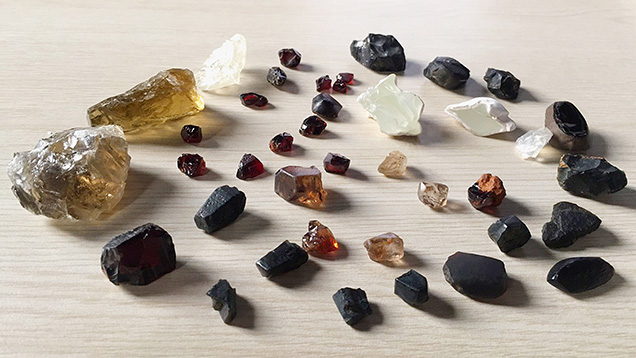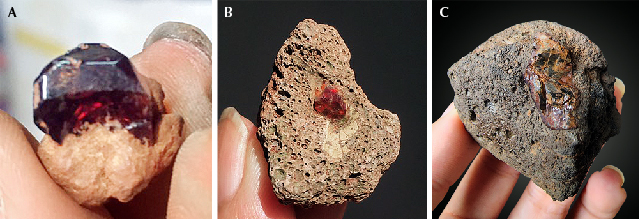Mining Basalt-Related Gems in Southeast Vietnam

A number of gemstone deposits are known in provinces all across Vietnam. These include ruby (Yen Bai and Nghe An), sapphire (Yen Bai, Nghe An, Binh Thuan, and Dak Nong), spinel (Yen Bai and the Central Highlands), aquamarine (Thanh Hoa and Khanh Hoa), tourmaline and garnet (Yen Bai), and peridot (Gia Lai). Recently, seven gemstone occurrences have been identified within the basaltic fields in southeast Vietnam, which are mainly found in Dong Nai and Ba Ria–Vung Tau provinces. These gems include sapphire, zircon, garnet, augite, brown peridot, feldspar, and hyalite opal. They are found predominantly in basalt bedrock and its regolith as xenocrysts or xenoliths deposited on hillslopes or in placer formations along streambeds. Seven gemstone species from southeast Vietnam were collected and documented (figure 1).
The sapphires usually appeared as hexagonal crystals or fragments, exhibiting mainly blue, deep to dark greenish blue, and greenish yellow colors. Most were transparent to semitranslucent and some opaque, and the luster was greasy to vitreous. The typical rough sizes ranged from 5 to 20 mm, weighing 2–10 ct.

Euhedral tetragonal crystals of zircon were very common, while the rest of them were fragmented. Colors included orange, brown-red, gray, and colorless. These zircon samples showed high luster ranging from adamantine to vitreous, with a transparent to semitransparent appearance. Zircons from southeast Vietnam were not found in fresh basalt; they were found mostly in placer and in weathered basalt instead (figure 2A).
“Red stone” is a local name for gem-quality garnet from Dong Nai. The garnets occurred in two forms of anhedral fragments: xenocrystic fragments (also called “orphan stone”) weighing 1–50 ct, with a corroded surface, and xenolith-hosted garnet containing small corroded fragments that produce 1–5 ct fashioned gems. Both xenocryst (figure 2B) and xenolith-hosted garnet were found mainly in the regolith on the hillslopes. The color ranged from deep to dark red and occasionally deep orangy yellow, with a transparent to semitransparent quality and a vitreous luster.
Euhedral crystals of Dong Nai feldspar were characterized by two directions of perfect cleavage. These feldspars were colorless, gray, and rarely light yellow, with a vitreous luster and a transparent to translucent appearance. This mineral was the most common gem material in the region and could be found in both bedrock and its regolith.
As reported recently, the augite samples appeared black under daylight-equivalent illumination but displayed green and brown colors under transmitted light. Most samples were transparent to translucent and had vitreous luster. The brown gems tended to be more transparent than the green ones (L.N. Nang et al., “Gem-quality augite from Dong Nai, Vietnam,” Summer 2023 G&G, pp. 182–194).
Brown peridot was found as slightly corroded xenocrystic fragments measuring 0.5–5 cm. The samples were black under reflected light but greenish yellow-brown with transmitted light. Most samples were transparent to translucent, with a vitreous luster. The brown peridot was quite rare and frequently confused with augite due to their similar morphology and occurrence in the vesicular basalt (figure 2C).
The hyalite opal was found in Ba Ria–Vung Tau, and each sample consisted of two parts: the inner body and the outer layer. The contact between the two parts was distinct. The outer layer was opaque white, 2–5 mm thick, and porous. The inner body was usually colorless and rarely green, brown, or light pink, transparent to opaque, with a vitreous appearance. The hyalite opals with good transparency were suitable for jewelry due to their glowing green fluorescence under long-wave ultraviolet light (weak fluorescence under short-wave UV).
Several of these gem deposits in southeast Vietnam are unlicensed. Most materials were collected by locals using artisanal methods, without any commercial mining. The gem materials found along hillslopes or stream channels were extracted at shallow depths ranging from 0.3 to 0.5 m. The gems appeared more frequently after rain and were distributed by their specific gravity. For instance, light material such as hyalite opal was concentrated on the hilltop, stored in slightly weathered and broken-up rock, while heavier minerals, namely sapphire, garnet, feldspar, and peridot, usually accumulated along the hillslopes. Zircon, on the other hand, was often deposited in streambeds. Some gems stored in basalt were extracted easily by homemade tools.
Most of the rough materials are sold to gem dealers in Ho Chi Minh City, who sell fashioned products to local markets in southeast Vietnam. Gemstones in the area have long been gathered by locals during farming and well drilling, but the old-fashioned mining methods led to a significant waste of gem resources. Preliminary evaluations of gem quality have shown that gemstones from southeast Vietnam are of economic potential. The thick basaltic host rock covering a large area is a foundation for prospecting numerous gem materials and requires further research to comprehensively assess available reserves.



